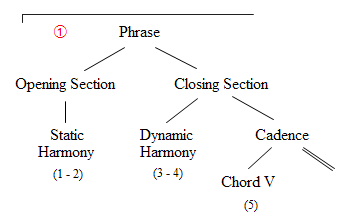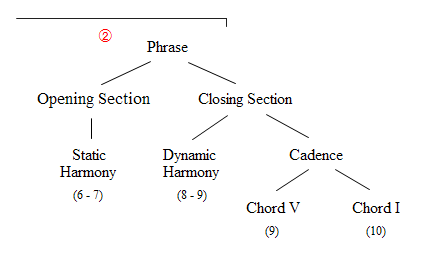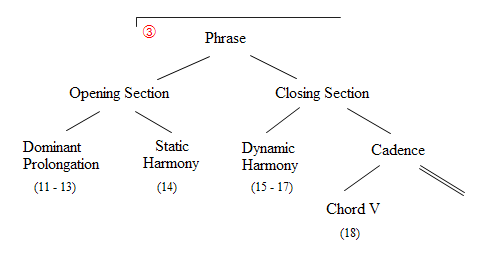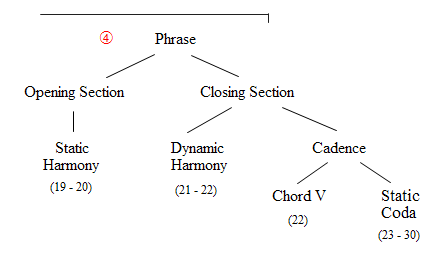CHAPTER 8 - EXAMPLE MUSICAL ANALYSES
BRAHMS ST ANTONI CHORALE VARIATIONS
Step 4 - Identify the Musical Phrase Structures
Now that we have established the underlying root progression patterns and noted how these form episodes of static harmony and dynamic harmony, we can see how these episodes form musical phrase structures. This example shows how complete and incomplete phrase structures combine to form larger syntactic structures that relate to the formal structure of the whole movement. For a summary of the main variations of the basic syntactic structure and how they are used see Chapter 6: Extensions to the Basic Structure.
Phrase 1 (bars 1 to 5).
We can see from the preceding root progression analysis and from the analytical outline, that this phrase starts with a 2 bar segment of static harmony (I - IV - I) prolonging the tonic Eb chord. This is followed by dynamic harmony (one beta progression followed by three alpha progressions) from bar 3 to bar 5. This phrase ends with a cadence which includes only the dominant chord, so that this phrase forms an incomplete musical phrase structure. The phrase is incomplete because it contains all but one of the basic syntactic elements. As indicated in the syntax diagram, below, and in the analytical outline, it contains: the opening section static harmony (bars 1 to 2), the closing section dynamic harmony (bars 3 to 4) and chord V of the cadence but NOT the final chord I. This absence of the tonic chord is indicated by the double dash. The phrase therefore ends with an imperfect cadence and can be referred to as an "imperfect phrase".
The syntactic structure, created by the root progression patterns, can thus be represented in the syntax diagram as follows:

The number 1 in a circle, in the piano reduction and analysis outline, indicates that this is phrase 1. As the final chord I is absent, this is an incomplete phrase structure and requires a complete structure to conjoin with in order to be completed. This function is carried out by phrase 2 as explained in the next section. The beam (or horizontal bracket) above indicates that this is part of, and starts off a larger overall conjoined phrase.
Phrase 2 (bars 6 to 10)
As previously indicated, this phrase is similar to phrase 1 with the exception that it ends with a tonic chord which forms a perfect cadence. The phrase is thus a complete phrase.
Opening section static harmony (I - IV - I) occurs in bars 6 to 7 and the closing section dynamic harmony (one beta progression followed by three alpha progressions), occurs in bars 8 to 9. The phrase is completed by a perfect cadence (V - I) in bars 9 to 10. This is represented by the syntax diagram as follows:

The beam above phrase 2 indicates that it is conjoined to phrase 1 in order to form a larger complete phrase. This is consistent with the overall formal structure of the piece as this aligns with the first repeated section of the movement, which is section "A" as indicated in the formal analysis.
Phrase 3 (bars 11 to 18)
This phrase is section "B" of the formal structure. It also starts with static harmony. The difference is that this static harmony is a prolongation of the dominant chord rather than the tonic chord as explained in the root progression analysis above. The standard syntactic structure, here is extended since the Opening Section static harmony is preceded by a Dynamic Introduction. In this case only the dominant (in the form of the dominant prolongation) is present in the Dynamic Introduction. This forms a kind of extended dominant upbeat to the static harmony of the phrase. As this extension involves the addition of a syntactic element, I will refer to this type of extension as "embedding". For more on this see Chapter 6: Extensions to the Basic Structure. The brief, one bar, opening section static harmony is followed by dynamic harmony and an imperfect cadence, as in phrase 1. The phrase is thus incomplete and requires a complete phrase to conjoin with in order to form a larger complete phrase.
The syntactic structure can thus be represented in the syntax diagram as follows:

The dominant prolongation is more commonly used to extend a phrase by prolonging the dominant chord of the cadence. However it is also frequently used as a lead in to the final complete phrase of a movement as it is here. This gives the listener a clue to the arrival of the final full structure and makes clear the overall form of the music.
Phrase 4 (bars 19 to 30)
Bars 19 to 22 are similar to bars 6 to 9 of sub phrase 2. This final phrase represents the extended repeat of the main subject " A' " and starts off as a basic syntactic structure. See explanation of phrase 2, above. The difference is that after the dominant chord (bar 22) of the cadence, the cadential tonic chord is prolonged by further static harmony based around the tonic chord. (Bars 23 to 30). This is a static harmony pattern that prolongs the tonic chord of the cadence as explained in the preceding sections. This is one of the two ways of extending the standard musical phrase structure without adding an additional syntactic element. This static coda is underscored by a tonic pedal. See Chapter 5: The Static Coda. The syntactic structure of phrase 4 can thus be represented by the syntax diagram as follows:

This complete phrase forms a larger unit by conjoining with phrase 3 which is incomplete on its own. The beams above phrases 3 and 4 indicates this conjoining.
The overall structure of the movement is thus two sets of conjoined phrases. The second starting with a dominant prolongation which indicates that it is the final complete phrase of the movement.
Summary
The preceding analyses show how the surface voice leading patterns combine to form motivic structures which in turn form melodies. These voice leading patterns are sometimes constructed in layers, resulting in non-functional chords such as passing chords, auxiliary chords and appoggiatura chords. Once the voice leading surface is accounted for, the underlying root progression patterns are revealed and these follow familiar patterns for tonal music. The root progression patterns are segmented into alternating segments of static harmony and dynamic harmony. Static harmony is made up of a prolongation of chord I or chord V. Examples of both are included in this analysis. Dynamic harmony is composed of a series of strong chord progressions. All the root progressions in the dynamic harmony episodes in this piece are either rising 4th (α) or falling 3rd (β) progressions. These are the two most common root progressions in dynamic harmony in tonal music. This polarisation is typical of Romantic period dynamic harmony as there is a predominance of falling 3rd (β) progressions. The choice of auxiliary chords in static harmony and the choice of root progression in dynamic harmony both contribute to the style and period of the music.
This analysis also shows how segments of static and dynamic harmony form the fundamental building blocks of the phrase structure of tonal music. Just as in Language, the basic structure can be extended. This example shows two ways of extending a standard structure: firstly by embedding a Dynamic Introduction and secondly by extending the final tonic chord (Static Coda). It also shows examples of incomplete and complete structures and how these can be conjoined to form larger structures.
This demonstrates how the three syntaxes (voice leading, root progressions and phrase structure) work together to create content and structure in tonal music. Similar, but slightly different patterns can also be observed in music that is base on modal scales and harmonies. The differences are indicators of the style of the music.
This has some similarities to the way that the three main syntaxes in language work together: phonetics that governs the structure of sounds; morphology that governs the structure of words; syntax which governs the structure of sentences. See the section connection with linguistics.
This forms a much richer analysis of the music than by other methods and brings together a combination of elements of musical analysis: formal, motivic, thematic, voice leading, root progression and phrase syntax. The method is also sensitive to the style of the music.

